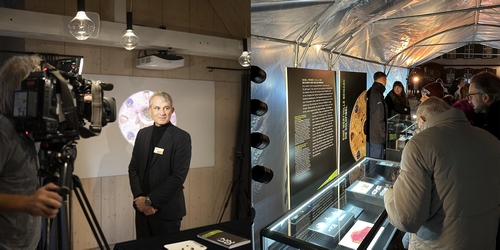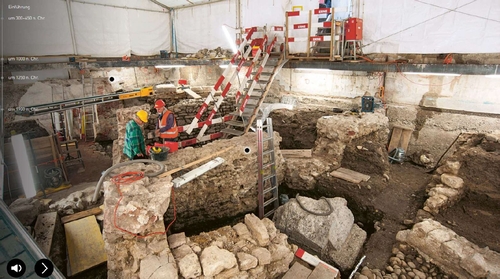Cite this as: Lassau, G. 2025 Pipes tell Basel's Urban History. Archaeology and the Expansion of the District's Heating Network, Internet Archaeology 70. https://doi.org/10.11141/ia.70.14
Basel has a rich cultural heritage. It is the third-largest city in Switzerland, with a population of some 176,000 inhabitants, and is characterised by a vibrant economy and cultural diversity. Various global enterprises have their headquarters in Basel, and the city is home an extraordinarily vast range of internationally renowned works of art and architecture within a relatively small area. Investment in construction has doubled in recent years, which has resulted in numerous highly publicised archaeological excavations taking place. In order for the Archaeology Service to act as a partner with urban developers, a reliable planning process is of crucial importance, and raising public awareness of Basel's archaeological heritage by education and outreach work is one of our top priorities.
The Archaeology Service has overseen the maintenance of the archaeological heritage of Canton Basel-Stadt since 1962. Basel's well-preserved historical centre, the largest in Switzerland by surface area, extends on both sides of the River Rhine, and it can look back on over 2000 years of uninterrupted settlement activity (Figure 1). Münsterhügel forms the city's nucleus, and is a reference point for late Celtic, Roman and medieval research. In the late La Tène period, around 80 BC, an oppidum with an imposing ditch and bank system was established on the hill, replacing the Celtic settlement known as 'Basel-Gasfabrik', an unfortified central place with two cemeteries. After the Gallic Wars, the oppidum was stripped back to become a Roman vicus. In the late 3rd century, Münsterhügel was fortified. In AD 374, Emperor Valentinian I came to 'Basilia' to oversee fortification of the border. Following the withdrawal of the Roman army, the Romanised population retained both Late Antique traditions and the Christian faith, despite their close proximity to Germanic groups (Lassau and Schwarz 2024, 12, 275–277).

Romanic and Frankish influence paved the way for the development that ultimately resulted in Basel becoming an episcopal town. After the year 800, Charlemagne ordered the construction of the first Basel cathedral, the successor buildings of which characterise the cityscape today. A bishop's precinct evolved on Münsterhügel, and was surrounded by numerous church parishes. In the 9th/10th centuries, settlement activities commenced at the foot of the hill. Up to around 1100, development was not particularly dense, and the town still had many agricultural areas (Sieber and Schwarz 2024, 20–23). Stone buildings began to be constructed from the 12th century onwards, orientated towards the streets and banks of the rivers Birsig and Rhine. Over the course of the Middle Ages, Basel had three different fortification systems. By the 15th century, it had grown to c. 130 hectares (320 acres), with a population of just over 10,000 (Bernasconi et al. 2023, 122–31).
As a consequence of industrialisation, entire residential streets in the historic centre were demolished around 1900. In the period between 1800 and 1850, the population had doubled to 30,000 inhabitants, and new residential quarters and industrial precincts were systematically constructed in the surrounding countryside.
The cantonal government of Basel-Stadt treats climate protection as a priority. In 2022 the population voted in favour of achieving net-zero by 2037, with one of the measures being the expansion of the district's heating network. Building the necessary infrastructure, comprising a network measuring over 60km in length, will result in c. 45 extra construction projects each year. The sustainable treatment of the original archaeological features is challenging, as laying the heating pipes largely involves disturbing intact layers. At the same time the resulting extensive archaeological insights provide us with a unique opportunity to reconstruct the city's past on a grand scale. Because of the accelerated expansion of the district's heating system, three teams of archaeologists were required to carry out excavations throughout the city in 2022. The rescue excavations were planned well in advance and in close cooperation with the developers. This was possible thanks to an extensive database of some 3650 known sites. The excavations that are currently ongoing in Kleinbasel on the right bank of the River Rhine have uncovered 17 early medieval burials. Some of the deceased were interred with precious grave goods, for instance one girl had a belt buckle with gold inlay and jewellery consisting of 380 beads. The highlight, however, was the discovery of a gold disc brooch in a woman's richly furnished 7th-century grave (Graber et al. 2023, 102–11). Rescue excavations on the Marktplatz in the centre of the city, and on Freie Strasse, have led to many new insights into the history of the medieval city centre (Figure 2).

4. Raising awareness through public relations work
It is a basic remit of the Archaeology Service to raise public awareness of the links between their place of residence and its archaeological heritage. Besides public relations work and a social media presence, this includes numerous other activities such as poster exhibitions. The most exciting finds from the early medieval burials excavated during the expansion of the district's heating network in 2021/2022 were presented to the public for the first time at a Night of Museums in January 2023, as part of a pop-up exhibition entitled 'Discovered in Kleinbasel' (Figure 3). Because of the importance of the recent finds from Marktplatz and Freie Strasse, a special exhibition entitled 'Recovered from below ground. Archaeological finds from the centre of Basel' opened at the Museum Kleines Klingental in 2024 (Bernasconi et al. 2024, 6–19).

One of the pillars of our public relations work is a network of 25 archaeological information points located at original findspots (Figures 4 and 5). One of the information points, presenting medieval finds and architectural remains uncovered in 2019, can be found in a new building that houses the Department of the Environment and Energy, a beacon of sustainable development. The important phases in Basel's history can also be explored on a circuit of Münsterhügel. From May to October 2023, a total of 59,226 people visited the information point 'Basel, AD 820–1500 The crypt beneath the cathedral crossing', which presents the architectural remains of Basel Cathedral dating from the period of Charlemagne to the Reformation.
Effective public relations work, archaeological lobbying at the planning stage for construction projects based on reliable archaeological data, and close coordination during the construction phase, have resulted in a situation where the Archaeology Service is now viewed as a partner and asset when it comes to the realisation of public works projects.

Internet Archaeology is an open access journal based in the Department of Archaeology, University of York. Except where otherwise noted, content from this work may be used under the terms of the Creative Commons Attribution 3.0 (CC BY) Unported licence, which permits unrestricted use, distribution, and reproduction in any medium, provided that attribution to the author(s), the title of the work, the Internet Archaeology journal and the relevant URL/DOI are given.
Terms and Conditions | Legal Statements | Privacy Policy | Cookies Policy | Citing Internet Archaeology
Internet Archaeology content is preserved for the long term with the Archaeology Data Service. Help sustain and support open access publication by donating to our Open Access Archaeology Fund.